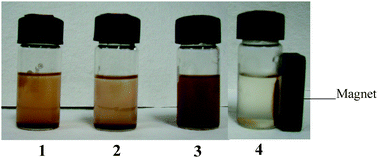Simultaneous purification and immobilization of Candida rugosalipase on superparamagnetic Fe3O4nanoparticles for catalyzing transesterification reactions
Abstract
The Fe3O4 superparamagnetic

* Corresponding authors
a
Chemistry Department, Indian Institute of Technology Delhi, Hauz Khas, New Delhi 110016, India
E-mail:
munishwar48@yahoo.co.uk
Fax: +91 11-26581073
Tel: +91 11-26591503
The Fe3O4 superparamagnetic

 Please wait while we load your content...
Something went wrong. Try again?
Please wait while we load your content...
Something went wrong. Try again?
K. Solanki and M.N. Gupta, New J. Chem., 2011, 35, 2551 DOI: 10.1039/C1NJ20277D
To request permission to reproduce material from this article, please go to the Copyright Clearance Center request page.
If you are an author contributing to an RSC publication, you do not need to request permission provided correct acknowledgement is given.
If you are the author of this article, you do not need to request permission to reproduce figures and diagrams provided correct acknowledgement is given. If you want to reproduce the whole article in a third-party publication (excluding your thesis/dissertation for which permission is not required) please go to the Copyright Clearance Center request page.
Read more about how to correctly acknowledge RSC content.
 Fetching data from CrossRef.
Fetching data from CrossRef.
This may take some time to load.
Loading related content
